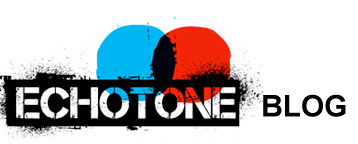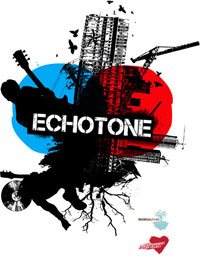More than a Year and a Half in Pursuit
When we started filming in April 2008, we weren’t clear where we were headed. We didn’t know where or how the story would present itself. All we had to do was look up to know that something was brewing in Austin. The dozen-plus high-rise condos hung over everything, most of them just shells. I’d been hearing rueful whispers about our town:
“It’s turning into a city, but it still thinks it’s a sleepy town.”
We knew we liked the music happening around us. Belaire, White Denim, Black Joe Lewis. Something seemed to be happening, but when Robert Garza (Echotone’s Director of Photography) and I discussed the burgeoning vision of the project, we avoided the phrase “music scene” like cancer. There was something so presumptuous about it, as true as it might have been.
We were also extremely leery of music documentaries that relied on the cultural cache of movements and zeitgeists that happened decades before.
“You shoulda been there,” they’d tell us. “But if you had been there, so and so would’ve broken your fuckin’ nose.”
Even the documentaries I respected like American Hardcore or Kill Your Idols read to me more like vital historical relics than anything else. We get the sense that the opinions and viewpoints are cemented in time. Kill Your Idols, about the so-called No Wave movement that surfaced in NYC in the early 1980s, attempted to bridge the gap from the old vanguard (Lydia Lunch, DNA, Sonic Youth) to the new (The Liars, Yeah Yeah Yeahs, Black Dice). It trips itself up, though, in its determination to define the musical culture of New York. There are tons of talking heads, which we knew we wanted to keep to a minimum in our film. Our maxim from the gate was that a film about music should be as kinetic as the music itself. It shouldn’t be chock-full of people telling you how you should feel.
The seminal influences for Echotone’s baby steps forward were the Maysles Brothers’ Gimme Shelter (About the 1969 Rolling Stones Altamount show that ended in four deaths. A true freak show. Feels like the end of an era. Its extended depictions of crowds flowing from all across the world to see the Stones is breathtaking.), D.A. Pennebaker’s Monterey Pop (filming Janis Joplin’s foot stomping while she wails is a stroke of genius), and Penelope Spheeris’ The Decline of Western Civilization.
Western Civilization was clearly directed by someone entrenched in the culture, riled and probably even scared by it. It was shot in a small cluster of L.A. clubs over the course of a few months in 1980. Spheeris depicts a world in a state of near-anarchy, as groups like X, Black Flag, and the Germs blur the lines between rage, politics, poverty, and music. The beauty of her particular form of documentary lies in that it confronts a particular moment in history, when the future seemed unwritten. Western Civilization is not looking back on an era with rosy-colored glasses. It is made by a fan wanting to dig deeper not only into the music itself, but the surrounding sociological factors, the press, and the upheaval of the American identity proper. It feels unsafe, volatile, alive.
I’m not sure what sort of cultural hype L.A. punk carried at the time the film was released, but I’ll bet it seemed like bullshit to anyone that was actually there. Which brings me to Austin, TX, circa now. Look no further than the recent New York Times travel article “36 Hours in Austin, TX”. It does well to allude that the city is in supreme flux, but its tips to tourists are unfortunately the same old phoned-in mainstays. It might as well read:
Mosey on out of the downtown Hilton, pardner, put on yer cowboy duds and head on down to the Broken Spoke for some good ol’ honky tonk.
Before it takes the absurd cowboy clichés too far, it makes sure to mention the city’s ubiquitous slogan “Keep Austin Weird.”
This is the home of Janis Joplin, reminded. And, you know, Willie Nelson, who we all know bridged the hippie/cowboy divide in the 60s, and Stevie Ray Vaughan. There’s Scratch Acid, Doug Sahm, Lightnin’ Hopkins and (most relevant to me) Townes Van Zandt and Daniel Johnston and the wailing 13th Floor Elevators. There’s a cultural history here, and it’s anything but dead.
Certainly the New York Times has a bottom line in the realm of tourist dollars, but their cultural snapshot of my town misses the mark by totally neglecting the Red River District, the epicenter for Austin’s current cultural renaissance.
It’s with this spirit that our cinematic journey began, with a balanced blend of love, desire, torpor, impending financial ruin, investor faith and generosity, Lone Star beer, creative connections, and the need, however improbable, to ascribe some meaning to our rapid and frenzied times. There was also a sense of urgency to the whole endeavor. Look at NYC’s St. Mark’s Place or dot com bubble San Francisco as proof that culture can go away, or shift so drastically as to be unrecognizable.
It became clear to me that Austin was at a very similar crossroads. On one hand, the music is as good as it’s ever been. On the other hand, musicians can no longer afford to live downtown, there are midnight curfews for playing outside, and renewed noise ordinances are popping up all over the city. The concept of the “ecotone,” the metaphorical moment where nature and civilization meet, organically grew out of the issues everyone seemed to be talking about.
This will be the first of many writings that attempt to illuminate the independent filmmaking experience as I have experienced it over the course of directing ECHOTONE.


The first of many…
I cannot wait!!!